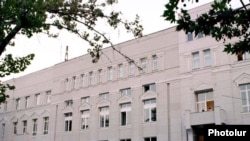Like the Russian ruble, the dram weakened against the U.S. dollar and the euro in the immediate aftermath of the invasion but rallied strongly in the following months. Since the outbreak of the war on February 24, the dram has strengthened by 13 percent against the dollar and 22 percent against the euro on aggregate.
The Armenian currency has been boosted by relative macroeconomic stability in Russia, Armenia’s number trading partner, as well as an influx of thousands of mostly middle-class Russians. Its continuing appreciation is prompting growing concerns from Armenian companies oriented towards Western and other non-Russian markets.
They include Gloria, the country’s largest textile factory located in the northern city of Vanadzor. Its owner, Bagrat Darbinian, complained on Tuesday that Gloria has been hit hard by the stronger dram because it sells the bulk of clothing manufactured by it in Europe.
Darbinian said he has to cut production costs to make up for the loss of revenue. He said he has already told the company’s workers to agree to a 30 percent reduction in their wages or risk being sent on unpaid leave or losing their jobs altogether.
“I am ashamed of entering our production units,” Darbinian told RFE/RL’s Armenian Service. “People are already not paid much and I want to cut their wages. But there is no other way out.”
The businessman, who claims to have invested $5 million in the factory in the last three years, said he has already appealed to Armenia’s government and Central Bank to help weaken the dram.
The authorities are receiving similar complaints from other export-oriented entrepreneurs and business executives, notably representatives of Armenian software companies.
The Central Bank governor, Martin Galstian, made clear on Tuesday that the bank will not cut interest rates or intervene in the domestic currency market to cut the dram’s value. Galstian said that the stronger dram is somewhat easing inflationary pressures on the Armenian economy aggravated by the Ukraine war.
“By artificially weakening the dram we would create an even worse inflationary situation which would hit all citizens, including exporters,” he told reporters.
Galstian also argued that the stronger dram is making many imported raw materials cheaper for exporters.






